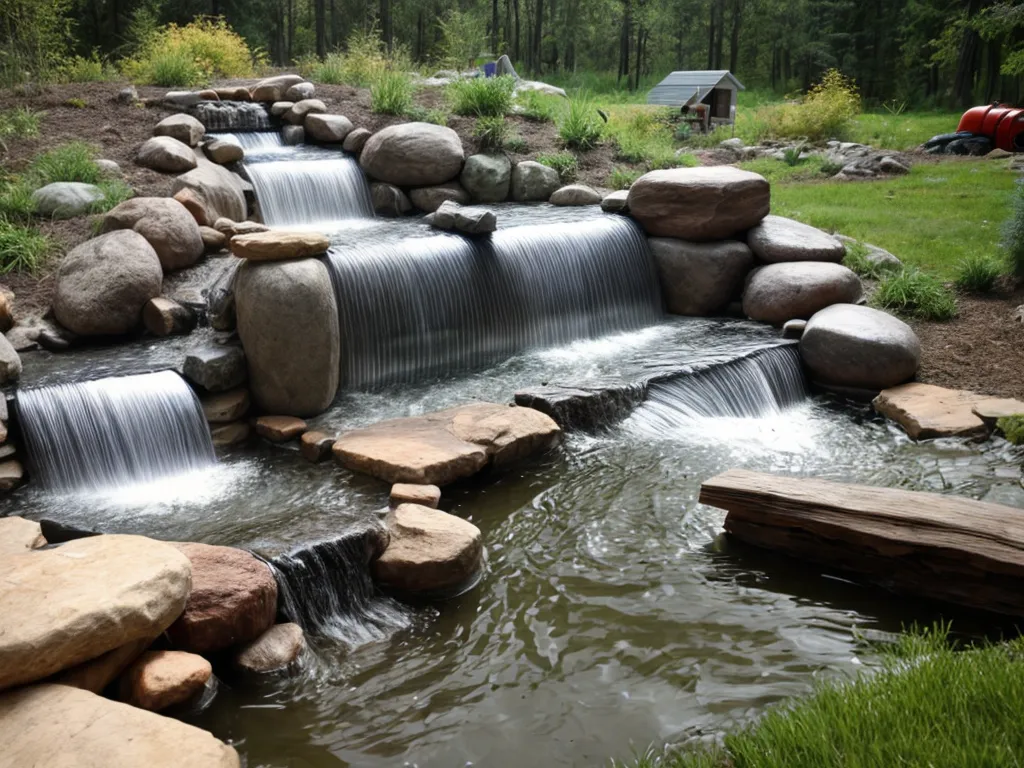
I have been interested in renewable energy for a long time. Recently, I started looking into building a small scale hydropower system to generate electricity in my backyard. Hydropower is one of the oldest and most reliable sources of renewable energy. By harnessing the power of flowing water, it is possible to generate electricity to power your home. Here is everything I learned about building a DIY backyard hydropower system.
Evaluating Your Site
The first step is to evaluate if your site has the necessary conditions to support a backyard hydropower system. There are several factors to consider:
Water Source
You need access to a flowing water source on your property, such as a stream, creek, or waterfall. The water flow rate and volume will determine the potential power output. As a rule of thumb, each gallon per minute of flow can produce about 1 watt of electricity.
Head Height
Head height is the vertical drop distance between your water source and turbine placement. More head height allows you to generate more electricity. Aim for at least 2 feet of head height if possible.
Siting
Choose a location to install the turbine that is easily accessible for maintenance and connecting to your home's electrical system. Make sure the site will remain unaffected by floods or debris.
If your property does not meet these criteria, building a backyard hydropower system may not be feasible. Consulting with an expert can help evaluate if your site has potential.
Sizing Your System
Once you have confirmed your site is suitable, the next step is sizing your system. Determine the following specifications:
- Expected flow rate (gallons per minute)
- Head height (vertical drop)
- Desired power output (watts)
With this information, you can select an appropriately sized turbine, generator, and other components. As a general guideline:
- Flow rates under 20 GPM are best suited for micro hydropower systems generating up to 2000 watts.
- Larger flow rates can accommodate bigger systems producing 5-100 kilowatts.
Consulting a sizing calculator or hydropower expert is recommended to get an accurate system design. Oversizing your system will lead to inefficiency and higher costs.
Choosing a Turbine
There are two main types of turbines suitable for DIY backyard hydropower:
Impulse Turbine
This turbine uses the velocity of water to turn the runner and operates best with high head heights above 30 feet. Common impulse turbine designs are Pelton and Turgo turbines.
Reaction Turbine
Reaction turbines generate power from the pressure and movement of water. They are better suited for low head heights under 30 feet. Propeller turbines, Francis turbines, and Archimedes screws are examples of reaction turbines.
Compare turbine types and select one optimized for your site's specific head height and flow rate. Impulse turbines are simpler to build at home but have limitations.
Generator and Electrical Components
The spinning turbine turns an internal shaft connected to a generator to produce electricity. I will need:
- Generator matched to my turbine's power output. Permanent magnet alternators are easy to use.
- Controller to regulate power.
- Batteries to store electricity.
- Inverter to convert generated power from DC to AC current for household use.
Wiring and disconnect switches are required to safely connect the system to your home's electrical panel. Consult an electrician for installing the wiring.
Constructing Intake, Pipeline, and Housing
To direct water flow into the turbine, I will need:
-
Intake structure: Collects water from the stream into a diversion or intake box. This may be a pre-built component.
-
Pipeline: Channels the water from the intake to the turbine housing. This is typically polyvinyl chloride (PVC) or steel piping. The pipeline size depends on my desired flow rate.
-
Turbine housing: Encloses the turbine and generator. Can be built from concrete, metal, or fiberglass.
The intake and pipeline must be large enough to avoid restricting water flow while keeping the system sealed. All housings and containers should be weatherproof and ventilated.
Installing and Testing System
Once constructed, it's time to install the hydropower system:
-
Mount the turbine and generator inside the housing, aligned with the pipeline intake opening.
-
Connect all electrical components like controller, inverter, and batteries according to the manufacturer's instructions.
-
Connect the system to household electric panel only after all wiring is complete.
-
Gradually increase water flow and check for leaks.
-
Monitor power output and flow rate to confirm the system is performing as expected.
-
Make adjustments to optimize power generation and efficiency.
Having the system inspected by a professional ensures all electrical connections are code-compliant and safe.
Ongoing Maintenance
Like any complex system, expect to perform regular maintenance:
-
Inspect intake, pipelines, and housings for damage, leaks, or blockages.
-
Check turbine and generator components for wear. Lubricate moving parts.
-
Clear debris and silt buildup.
-
Monitor electronic controls and calibrate if necessary.
-
Test batteries and replace as needed.
-
Tune up the system each year before high water flows in spring.
Maintenance ensures your DIY hydropower system will continue functioning safely and efficiently for years to come. Keeping detailed records of system performance over time allows you to spot issues early.
Final Thoughts
Constructing a small scale hydropower system is an involved but rewarding project. With proper site conditions and equipment sizing, homeowners with sufficient DIY skills can build their own backyard hydropower generator. This allows you to produce renewable electricity to reduce your energy bills and environmental impact. If designing and building the entire system from scratch seems daunting, there are also pre-made kits available to simplify the process. Just make sure to research all applicable permits and regulations in your area before getting started. With some diligent planning and preparation, you can harness the power of water to create your own hydroelectric oasis.